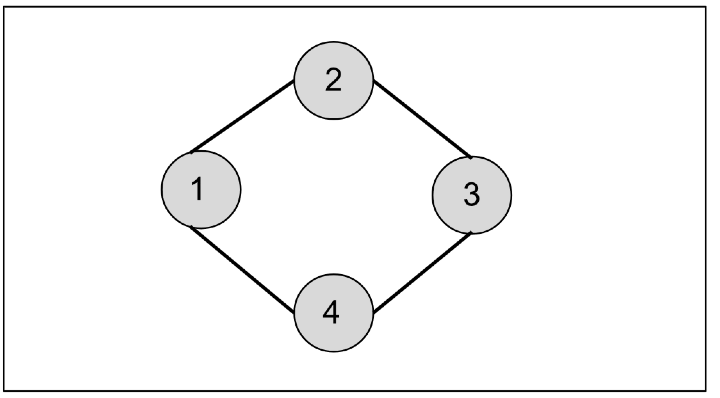Golang 广度优先搜索图
图是由边或者我们可以说节点和顶点组成的数据结构。顶点是节点之间的连接线。为了遍历所有这些节点,我们有不同的遍历算法。在本文中,我们将讨论广度优先搜索或者我们可以说BFS。在广度优先搜索中,我们首先从一个节点开始,然后移动到另一个节点,直到遇到死胡同。
范例

步骤
第一步: 使用import关键字在顶部导入所需的包。
第二步: 然后,主函数将首先运行。
- 首先,我们声明并初始化图。
-
然后,我们使用图和节点作为参数调用BFS()函数。
第三步: 在BFS()函数中,以下步骤将在每个函数调用上运行。
isvisited := make(map[int]bool)
创建一个用于存储节点是否已访问的数据的地图。
var bfsQueue Queue
为队列数据结构创建一个参数。
isvisited[node] = true, bfsQueue.Enqueue(node)
将通过的节点标记为已访问,并将节点添加到队列中。
对所有连接的节点运行一个for循环,并将它们添加到队列中。
示例1
在这个示例中,我们将图表示为一个矩阵,并对矩阵应用广度优先搜索。这种方法的复杂度为O(e*e),其中e是边的数量,空间复杂度为O(e*e),即矩阵的大小。
package main
import "fmt"
type Queue struct {
List []int
}
// function to add element in queue
func (q *Queue) Enqueue(element int) {
q.List = append(q.List, element)
}
// function to delete element in the queue
func (q *Queue) Dequeue() int {
if q.isEmpty() {
fmt.Println("Queue is empty.")
return 0
}
element := q.List[0]
q.List = q.List[1:]
return element
}
// function check that queue is empty or not
func (q *Queue) isEmpty() bool {
return len(q.List) == 0
}
// BFS() is a function with matrix and int value as parameter
func BFS(graph [][]int, node int) {
// initializing the map that will keep
// the track is the node is visited or not
isvisited := make(map[int]bool)
// creating a Queue variable
// in which we will add an element at the same level
// of that node
var bfsQueue Queue
// marking current node as visited
isvisited[node] = true
// adding a current node in the queue
bfsQueue.Enqueue(node)
// running a for loop until the queue becomes empty
for !bfsQueue.isEmpty() {
currNode := bfsQueue.List[0]
fmt.Print(currNode, " ")
// adding all the connected node in queue if not visted
for nodes := 0; nodes < len(graph[currNode]); nodes++ {
if graph[currNode][nodes] == 1 && !isvisited[nodes] {
bfsQueue.Enqueue(nodes)
isvisited[nodes] = true
}
}
// removing the current node from queue
// after visiting
bfsQueue.Dequeue()
}
}
func main() {
// matrix representation of the undirected connected graph
// where if the value is 1 the node i is connected
// with node j
graph := [][]int{{0, 1, 0, 1}, {1, 0, 1, 0}, {0, 1, 0, 1}, {1, 0, 1, 0}}
fmt.Println("Golang program to do Breath first search of an undirected connected graph represented in the form of a matrix.")
// calling BFS() function for the breadth-first search
// traversal of a graph
BFS(graph, 0)
fmt.Println()
}
输出
Golang program to do Breath first search of an undirected connected graph represented in the form of a matrix.
0 1 3 2
示例2
在这个示例中,我们将图表示为邻接表的形式,并相应地应用广度优先搜索。这种方法的复杂度为O(e*v),其中e是边的数量,v是顶点的数量。空间复杂度为O(e*v),即邻接表的大小。
package main
import "fmt"
type Queue struct {
List []int
}
// function to add an element in the queue
func (q *Queue) Enqueue(element int) {
q.List = append(q.List, element)
}
// function to delete elements in the queue
func (q *Queue) Dequeue() int {
if q.isEmpty() {
fmt.Println("Queue is empty.")
return 0
}
element := q.List[0]
q.List = q.List[1:]
return element
}
// function checks whether the queue is empty or not
func (q *Queue) isEmpty() bool {
return len(q.List) == 0
}
// BFS() is a function with matrix and int value as parameter
func BFS(graph [4][]int, node int) {
//Initializing the map that will keep
// the track is the node is visited or not
isvisited := make(map[int]bool)
// creating a Queue variable
// in which we will add elements at the same level
// of that node
var bfsQueue Queue
// marking current node as visited
isvisited[node] = true
// adding the current node in the queue
bfsQueue.Enqueue(node)
// running a for loop until the queue becomes empty
for !bfsQueue.isEmpty() {
currNode := bfsQueue.List[0]
fmt.Print(currNode, " ")
// adding all the connected nodes in the queue if not visited
for _, nodes := range graph[currNode] {
if !isvisited[nodes] {
bfsQueue.Enqueue(nodes)
isvisited[nodes] = true
}
}
// removing the current node from queue
// after visiting
bfsQueue.Dequeue()
}
}
func main() {
//adjacency list representation of the undirected connected graph
// where if the value is 1 the node i is connected
// with node j
var graph [4][]int
// initializing each list of the array
graph[0] = []int{1, 3}
graph[1] = []int{0, 2}
graph[2] = []int{1, 3}
graph[3] = []int{0, 2}
fmt.Println("Golang program to do Breath first search of an undirected connected graph represented in the form of an adjacency list.")
// calling BFS() function for the breadth-first search
// traversal of a graph
BFS(graph, 0)
fmt.Println()
}
输出
Golang program to do Breath first search of an undirected connected graph represented in the form of an adjacency list.
0 1 3 2
结论
这是表示图数据结构和运行广度优先搜索算法的两种不同方式。第二种方法是创建邻接表,从时间和空间的角度来看更高效,因为我们将与节点连接的节点编号添加到数组中。要了解更多关于Golang的知识,可以探索这些教程。
 极客笔记
极客笔记